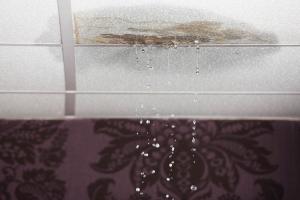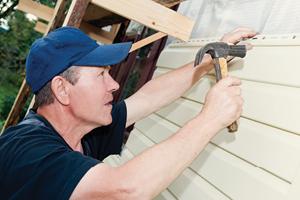What to do when a pipe bursts

In a winter cold spell, water pipes may develop ice and form a blockage. If left untreated, this can lead to increased pressure, causing the pipe to burst. Water damage and freezing is among the most common homeowner claims filed each year with an average loss of about $11,650 per claim. Follow these steps to help minimize the damage.
Shut off the water
A burst pipe will send water flooding into your home. Locate the main water supply and shut it off to stop the flow of water, preventing additional damage. Leave the faucets on to fully drain the pipe and relieve any remaining pressure, and flush all toilets. Depending on where the leak is, you may also need to shut off the electricity.
Repair the pipe
Call a plumber to make sure the pipe is repaired quickly and correctly. Attempting to repair the pipe yourself may cause further damage, so it’s best to rely on the experts.
Get rid of the water
The longer water stays in your home, the more potential there is for damage. Remove as much standing water as possible with a wet/dry vacuum, move waterlogged items to a warm, dry place, and set up fans or a dehumidifier in the area. Make sure the entire area is fully dry to avoid future issues with mold and mildew. For professional help, find a water mitigation contractor near you, or contact your insurance agent to help you locate a contractor.
Take inventory of damage
Make a complete list of any damaged property and possessions. Document the damage using a digital camera or your phone, so you and your insurance claims adjuster can easily reference it later. Save any receipts for repair expenses.
Contact your insurance agent
Water damage from burst pipes is typically covered under your standard homeowner policy, so begin your homeowners insurance claim immediately by contacting your insurance agent.
Prevent it from happening again
Once everything is cleaned up from a burst pipe, the last thing you want is for it to happen again. The temperature alert threshold for frozen pipes is 20°F, so when temperatures drop, it’s time to make sure your pipes are warm and water is running. Easy steps to help prevent pipes from freezing include:
- Keep the thermostat set to at least 55°F, even if you will be leaving your home for a few days of vacation.
- Slightly turn on faucets to keep water flowing.
- Open cabinet doors under sinks to help heat reach uninsulated pipes. For a more long-term solution, consider insulating exposed pipes, particularly pipes running along outside walls.
- Caulk and seal any leaks around your home that may allow cold air to enter close to pipes.
- Pay particular attention to pipes in unheated areas like basements, attics, crawl spaces and outside walls, especially in southern-climate homes that weren’t built with potential freezing in mind.
Consider additional coverage
While your basic homeowners policy typically covers damage from a burst pipe, you may need coverage for additional damage. Water backup coverage offers more coverage for instances like backed up drains or failed pumps, and service line coverage can protect you if flooding affects service lines on your property. If you have valuable jewelry, antiques or collectibles in your home, you may want to consider itemized coverage. Talk to your agent to help tailor your coverage for your unique needs.
Sources
Related resources
What to do when a pipe bursts
In a winter cold spell, water pipes may develop ice and form a blockage. If left untreated, this can lead to increased pressure, causing the pipe to burst. Water damage and freezing is among the most common homeowner claims filed each year with an average loss of about $11,650 per claim. Follow these steps to help minimize the damage.
Shut off the water
A burst pipe will send water flooding into your home. Locate the main water supply and shut it off to stop the flow of water, preventing additional damage. Leave the faucets on to fully drain the pipe and relieve any remaining pressure, and flush all toilets. Depending on where the leak is, you may also need to shut off the electricity.
Repair the pipe
Call a plumber to make sure the pipe is repaired quickly and correctly. Attempting to repair the pipe yourself may cause further damage, so it’s best to rely on the experts.
Get rid of the water
The longer water stays in your home, the more potential there is for damage. Remove as much standing water as possible with a wet/dry vacuum, move waterlogged items to a warm, dry place, and set up fans or a dehumidifier in the area. Make sure the entire area is fully dry to avoid future issues with mold and mildew. For professional help, find a water mitigation contractor near you, or contact your insurance agent to help you locate a contractor.
Take inventory of damage
Make a complete list of any damaged property and possessions. Document the damage using a digital camera or your phone, so you and your insurance claims adjuster can easily reference it later. Save any receipts for repair expenses.
Contact your insurance agent
Water damage from burst pipes is typically covered under your standard homeowner policy, so begin your homeowners insurance claim immediately by contacting your insurance agent.
Prevent it from happening again
Once everything is cleaned up from a burst pipe, the last thing you want is for it to happen again. The temperature alert threshold for frozen pipes is 20°F, so when temperatures drop, it’s time to make sure your pipes are warm and water is running. Easy steps to help prevent pipes from freezing include:
- Keep the thermostat set to at least 55°F, even if you will be leaving your home for a few days of vacation.
- Slightly turn on faucets to keep water flowing.
- Open cabinet doors under sinks to help heat reach uninsulated pipes. For a more long-term solution, consider insulating exposed pipes, particularly pipes running along outside walls.
- Caulk and seal any leaks around your home that may allow cold air to enter close to pipes.
- Pay particular attention to pipes in unheated areas like basements, attics, crawl spaces and outside walls, especially in southern-climate homes that weren’t built with potential freezing in mind.
Consider additional coverage
While your basic homeowners policy typically covers damage from a burst pipe, you may need coverage for additional damage. Water backup coverage offers more coverage for instances like backed up drains or failed pumps, and service line coverage can protect you if flooding affects service lines on your property. If you have valuable jewelry, antiques or collectibles in your home, you may want to consider itemized coverage. Talk to your agent to help tailor your coverage for your unique needs.
Sources
Related resources
What to do when a pipe bursts
In a winter cold spell, water pipes may develop ice and form a blockage. If left untreated, this can lead to increased pressure, causing the pipe to burst. Water damage and freezing is among the most common homeowner claims filed each year with an average loss of about $11,650 per claim. Follow these steps to help minimize the damage.
Shut off the water
A burst pipe will send water flooding into your home. Locate the main water supply and shut it off to stop the flow of water, preventing additional damage. Leave the faucets on to fully drain the pipe and relieve any remaining pressure, and flush all toilets. Depending on where the leak is, you may also need to shut off the electricity.
Repair the pipe
Call a plumber to make sure the pipe is repaired quickly and correctly. Attempting to repair the pipe yourself may cause further damage, so it’s best to rely on the experts.
Get rid of the water
The longer water stays in your home, the more potential there is for damage. Remove as much standing water as possible with a wet/dry vacuum, move waterlogged items to a warm, dry place, and set up fans or a dehumidifier in the area. Make sure the entire area is fully dry to avoid future issues with mold and mildew. For professional help, find a water mitigation contractor near you, or contact your insurance agent to help you locate a contractor.
Take inventory of damage
Make a complete list of any damaged property and possessions. Document the damage using a digital camera or your phone, so you and your insurance claims adjuster can easily reference it later. Save any receipts for repair expenses.
Contact your insurance agent
Water damage from burst pipes is typically covered under your standard homeowner policy, so begin your homeowners insurance claim immediately by contacting your insurance agent.
Prevent it from happening again
Once everything is cleaned up from a burst pipe, the last thing you want is for it to happen again. The temperature alert threshold for frozen pipes is 20°F, so when temperatures drop, it’s time to make sure your pipes are warm and water is running. Easy steps to help prevent pipes from freezing include:
- Keep the thermostat set to at least 55°F, even if you will be leaving your home for a few days of vacation.
- Slightly turn on faucets to keep water flowing.
- Open cabinet doors under sinks to help heat reach uninsulated pipes. For a more long-term solution, consider insulating exposed pipes, particularly pipes running along outside walls.
- Caulk and seal any leaks around your home that may allow cold air to enter close to pipes.
- Pay particular attention to pipes in unheated areas like basements, attics, crawl spaces and outside walls, especially in southern-climate homes that weren’t built with potential freezing in mind.
Consider additional coverage
While your basic homeowners policy typically covers damage from a burst pipe, you may need coverage for additional damage. Water backup coverage offers more coverage for instances like backed up drains or failed pumps, and service line coverage can protect you if flooding affects service lines on your property. If you have valuable jewelry, antiques or collectibles in your home, you may want to consider itemized coverage. Talk to your agent to help tailor your coverage for your unique needs.
Sources
Related resources
What to do when a pipe bursts
In a winter cold spell, water pipes may develop ice and form a blockage. If left untreated, this can lead to increased pressure, causing the pipe to burst. Water damage and freezing is among the most common homeowner claims filed each year with an average loss of about $11,650 per claim. Follow these steps to help minimize the damage.
Shut off the water
A burst pipe will send water flooding into your home. Locate the main water supply and shut it off to stop the flow of water, preventing additional damage. Leave the faucets on to fully drain the pipe and relieve any remaining pressure, and flush all toilets. Depending on where the leak is, you may also need to shut off the electricity.
Repair the pipe
Call a plumber to make sure the pipe is repaired quickly and correctly. Attempting to repair the pipe yourself may cause further damage, so it’s best to rely on the experts.
Get rid of the water
The longer water stays in your home, the more potential there is for damage. Remove as much standing water as possible with a wet/dry vacuum, move waterlogged items to a warm, dry place, and set up fans or a dehumidifier in the area. Make sure the entire area is fully dry to avoid future issues with mold and mildew. For professional help, find a water mitigation contractor near you, or contact your insurance agent to help you locate a contractor.
Take inventory of damage
Make a complete list of any damaged property and possessions. Document the damage using a digital camera or your phone, so you and your insurance claims adjuster can easily reference it later. Save any receipts for repair expenses.
Contact your insurance agent
Water damage from burst pipes is typically covered under your standard homeowner policy, so begin your homeowners insurance claim immediately by contacting your insurance agent.
Prevent it from happening again
Once everything is cleaned up from a burst pipe, the last thing you want is for it to happen again. The temperature alert threshold for frozen pipes is 20°F, so when temperatures drop, it’s time to make sure your pipes are warm and water is running. Easy steps to help prevent pipes from freezing include:
- Keep the thermostat set to at least 55°F, even if you will be leaving your home for a few days of vacation.
- Slightly turn on faucets to keep water flowing.
- Open cabinet doors under sinks to help heat reach uninsulated pipes. For a more long-term solution, consider insulating exposed pipes, particularly pipes running along outside walls.
- Caulk and seal any leaks around your home that may allow cold air to enter close to pipes.
- Pay particular attention to pipes in unheated areas like basements, attics, crawl spaces and outside walls, especially in southern-climate homes that weren’t built with potential freezing in mind.
Consider additional coverage
While your basic homeowners policy typically covers damage from a burst pipe, you may need coverage for additional damage. Water backup coverage offers more coverage for instances like backed up drains or failed pumps, and service line coverage can protect you if flooding affects service lines on your property. If you have valuable jewelry, antiques or collectibles in your home, you may want to consider itemized coverage. Talk to your agent to help tailor your coverage for your unique needs.
Sources





